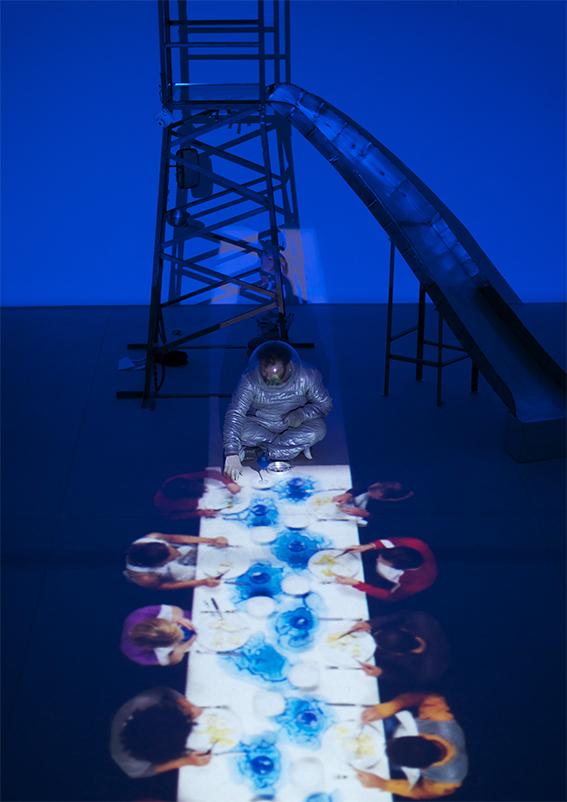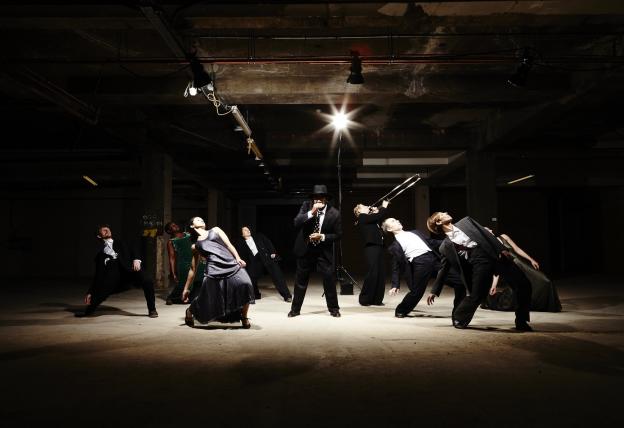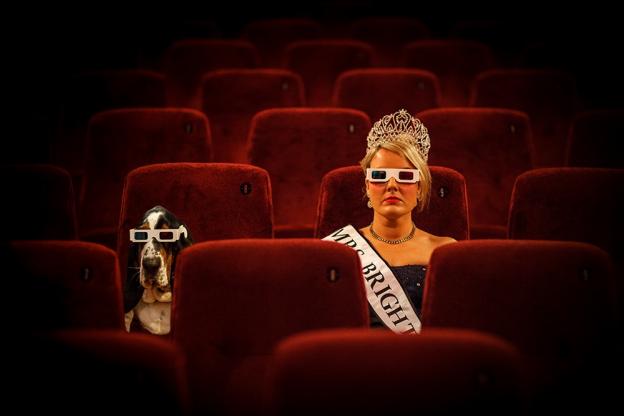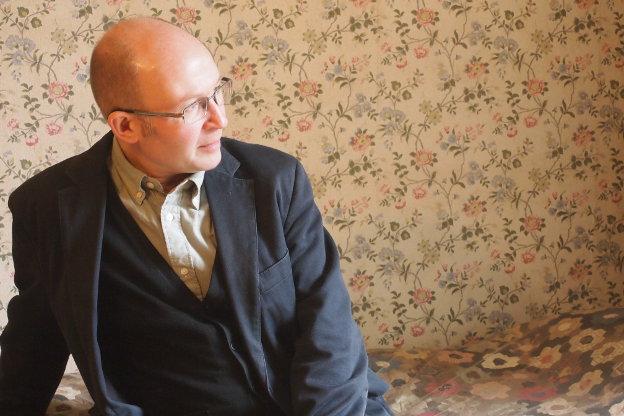Time – a long time, a short time, recent times, past times. Time – a moment that never passes. The past no longer exists, the future has never existed. There is only the present moment. The present is always – this. Yet still the hands of the clock turn, still the minutes tick by, still we wait for lift-off. Time waits for no man, and certainly for no woman either, so here we all are, and there they all are, caught in this moment forever: two retired ice-skaters making a desperate bid to relive past achievements; a soiled white bride who wants the dreams and desires of the future to satisfy the present, sailing from a great height down into a lake; an ashen black widow who wishes she could wipe out all that is lost, kneading the earth as if it were dough; a team of suited men who read and rant and roll through the hills; an astronaut whose bike was his first spaceship, commencing countdown to the tune of Thus Spoke Zarathustra whilst arranging absent friends into a dream dinner-party.
Cecilia Bertoni’s Trilogia dell’Assenza (Trilogy of Absence), set indoors in the arts centre (first and third shows) and outdoors in the luscious landscapes of the Tenuta dello Scompiglio in Tuscany (second show), is an epic production that takes its audience on a journey – both literally and metaphorically – to explore themes of winning and losing; of childhood shame and adult mortification; of innocence and experience, of presence and absence. And memory – ever-present memory that exists to taunt us, to pull us out of the present moment into a land of hopes and regrets. If only, if only… if only we could be like the Scompiglio dogs Didi and Gogo, always present in the moment. Ah, memory – the joy and curse of being human.
Part one is entitled Tesorino, perche hai perso? (Sweetheart, why did you lose?). We start indoors, in the theatre space, with the ice-skaters who’ve lost everything and want to get it back. It’s as if they are forever destined to overcome past humiliations and failures. They could be Adam and Eve trying to find their way back to a lost paradise. (In the second part of the trilogy a text from Nietzsche reaffirms this suggestion: ‘Smooth ice / Is paradise / For those who dance with expertise.’) Two recorded texts set the scene: a story of a ten-year-old boy’s shame and horror at being home-filmed in his underpants by his crowing father, following an unfortunate incident with a cowpat; and a ten-year-old girl’s humiliation at her Catholic Confirmation ceremony, wearing her emancipated mother’s choice of a cream dress and ‘Florentine’ straw hat, when every other little girl in the church is in virginal white dress and veil. Words, images and associations from these texts resonant throughout this first piece, and in the subsequent two other works in the trilogy. Our two skaters are pulled between gravity and levity: dangling from harnesses, clambering over a multi-tiered moveable scaffold, falling with full force to the ground. The ice is long gone, and with one skate off and one skate on, they hobble and posture and pose, preening themselves and each other. They are past their prime, but there is the hope of one last victory – even if it is just a victory over the other one. The onstage relationship between the two performers (creator of the trilogy Cecilia Bertoni, and French actor/co-creator of part one, Serge Cartellier) bears the mark of longtime collaboration and complicity. They are at ease in their roles and with the interactions of their two characters, creating a playful dynamic that balances the humour and pathos of their situation. The soundscape, by Carl G Beukman, expertly weaves spoken texts, crackling radio recordings and mindless muzaks together into a rich, multi-layered aural tapestry. Grainy videos (by Claire Guerrier) projected onto a rear screen and two small metal cases at the front of the performance space add a layer of visual imagery as hazy as half-remembered dreams. We believe unreservedly in the limbo world our two protagonists occupy, and in the situation that (inevitably) cannot be resolved.
Next we are escorted by a suited man wielding a megaphone into the great outdoors for part two, Riflessi in bianco e nero (Reflections in white and black). We journey through the woods and terraces of Scompiglio, cleverly guided by our man with the megaphone – it is great to witness the always challenging problem of how to lead and steward an audience being dealt with in a creatively interesting way. There are four stops along the way. At the highest point, we sip berry juice and gaze narcissistically into a mirror set into the ground, a pair of white ice skates hanging above, to one side an open dictionary marked at the definition of ‘memory’. Further down the terraces we meet the black widow (Marialucia Carones) and white bride (Serena Gatti), voicing laments and lullabies with their bodies, as harsh cracks and explosions sound across the hills, a posse of men posed on chairs above them. Our two ice-skaters appear as silent witnesses to the action. As we move on to Il Cemetero del Tempo (The Graveyard of Memory), a distorted recording exhorts us to ‘never look back’; the cemetery of decomposing metal beds and rusted gates becomes the site for a symphony of distressed dances and obsessive-compulsive actions. At the final stop, the lakeside Funerale del Tempo (Funeral of Time), we witness a wondrously beautiful scene: the widow close to the lake’s surface; the bride suspended on a harness terrifyingly high from one of the top branches of an extremely tall and magnificent old tree; the posse of men now dressed in vermillion red lounging on the banks, looking as if they are made from the same red brick of the house behind them. From clay we are made, to clay we return: dust to dust, ashes to ashes…
The third part of the trilogy, Kind of Blue (titled in English) returns us indoors, this time not to the black-box theatre but to a smaller white-cube gallery space in which we are seated on scaffolding, overlooking the only performer (our astronaut, Mauro Carulli), who in turn is placed inside a metal tower with a playground slide attached, and a bicycle leaning against it. The room becomes the site for a three-sided projection, on two walls and a floor, creating an unsettling and vertiginous perspective. There are echoes from the earlier two sections of the trilogy, but the connecting threads to this third piece feel slighter than the links between one and two – perhaps because we are meeting new characters (live and on film), and those we have already met have faded out of the action for the most part, their headless bodies passing by on the conveyer belt of film to each side of us, their heads arriving, like John the Baptist’s, as offerings on plates at the dream dinner party. Thematically, the main text used – from Nietzsche’s Also Sprach Zarathustra, reflecting on summit and abyss not as diametrically opposed concepts but as one and the same thing – ties us in very neatly to part one. The return to childish pleasures on the slide and the bicycle harp back to a section in Riflessi in bianco e nero in which we hear the gentle sounds of music boxes and ball games whilst gazing upon the antics of the occupants in the distressed playground of the Cemetery of Memories.
Each of these three parts of the Trilogia dell’Assenza is a self-contained and autonomous show. Kind of Blue is the newest of the three, and comes accompanied by a small exhibition/installation of photographs and other research materials. During the three-week run at Tenuta dello Scompiglio, the shows have sometimes been presented as separate works, and sometimes as a three-part experience over an afternoon and evening. The first and third part, sited as they are in theatre/gallery space, could be happily toured or presented in other theatres or arts centres. And even though the second show of the trilogy is site-specific to the spaces of Scompiglio, it could potentially be reworked for other spaces. Each of the three feel complete, but there is a special resonance in seeing all three together, noting the echoes and references and developments of the themes throughout.
Taken as a whole: this feels like a truly contemporary theatre – one that is indeed a crossroad of the arts (to steal a line from Jean-Louis Barrault). Original texts and found texts (from Nietzsche, Murakami, Pinter et al); autobiographical confession mixed with poetic reflection and semiotic wordplay; movement theatre and performance actions; montaged soundscapes; video projected in many different settings; short film; sets and structures that invite physical action; aerial performance; inventive lighting; installation in the landscape… the list of ways and means seems pretty endless. But the senses are not overloaded: there is time to savour each new development; there is space to really see and hear and feel what is being presented. The deep themes addressed – loss, failure, memory, regret, the passing of time – could, in other hands, lead to a heavy and wearying audience experience, but the balance is kept between light and dark. Absurd humour often cuts in to relieve the work of any overly oppressive elements, whilst also allowing us to feel the pain and angst of the individual and universal experiences of shame, bereavement and regret that permeate the work. Partaking of all three shows together in one sitting, it feels as if we have been fed a very generous and nutritious theatrical feast.





